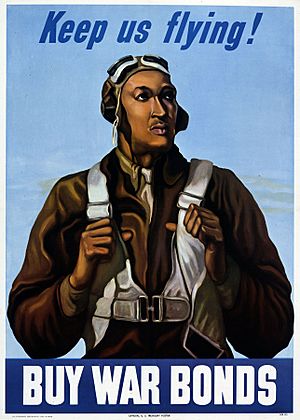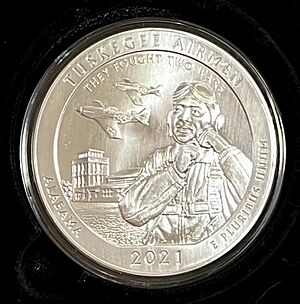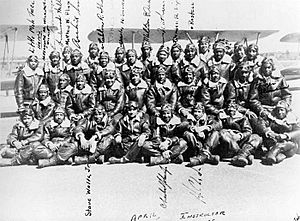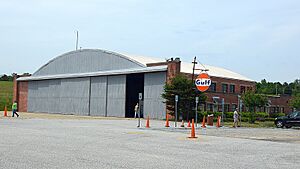Tuskegee Airmen National Historic Site facts for kids
|
Tuskegee Airmen National Historic Site
Tuskegee Institute Field #2 Moton Field |
|

Hangar 2 and the control tower at Moton Field
|
|
| Location | Tuskegee, Alabama, USA |
|---|---|
| Area | 89.68 acres (0.3629 km2) |
| Built | 1940 |
| Architect | U.S. Army |
| Website | Tuskegee Airmen National Historic Site |
| NRHP reference No. | 01000284 |
Quick facts for kids Significant dates |
|
| Added to NRHP | November 6, 1998 |
| Designated NHLD | November 6, 1998 |
The Tuskegee Airmen National Historic Site is a special place in Tuskegee, Alabama. It honors the amazing African-American pilots and support staff who served in World War II. This site is located at Moton Field, where these brave airmen first learned to fly.
Today, the National Park Service manages the site. They help visitors learn about the history and achievements of the Tuskegee Airmen. Moton Field was built in 1941 as a new training base. It was named after Robert Russa Moton, a former leader of the Tuskegee Institute.
Contents
Discovering the Tuskegee Airmen's Story
Before 1940, African Americans were not allowed to fly for the U.S. military. Many people and groups worked hard to change this rule. Because of their efforts, an all African-American pilot squadron was formed in 1941. This group was based in Tuskegee, Alabama.
They became known as the "Tuskegee Airmen." This name includes everyone involved in the "Tuskegee Experience." This program trained African Americans to fly and maintain military planes. It included pilots, navigators, and mechanics. About 16,000 people were part of this important program.
Why Tuskegee Was Chosen
The military chose Tuskegee Institute for pilot training for good reasons. The institute was already committed to teaching aviation. It had the right buildings and skilled teachers. The weather in Tuskegee also allowed for flying all year long.
The first students finished their training in May 1940. The Tuskegee program then grew much larger. It became the main center for African-American aviation during World War II.
Overcoming Challenges and Making History
The Tuskegee Airmen faced many challenges, including unfair treatment and segregation. Despite this, they became one of the most respected fighter groups in World War II. They proved that African Americans could fly and maintain complex warplanes.
Their success helped change the U.S. military forever. It paved the way for all military branches to become fully integrated. This meant people of all races could serve together.
The History of Moton Field
Moton Field was the only place where African-American pilots received their first flight training. This was during World War II. The field was named after Robert Russa Moton, the second president of Tuskegee Institute.
Building the Training Base
Moton Field was built between 1940 and 1942. Money for its construction came from the Julius Rosenwald Fund. The field was created to provide primary flight training for the U.S. military. Experts from Maxwell Field helped choose and map out the site.
Architect Edward C. Miller and engineer G. L. Washington designed many of the buildings. Archie A. Alexander, another engineer, managed the construction. Workers from Tuskegee Institute helped finish the field. This allowed flight training to begin on time.
How Training Worked
The Army Air Corps oversaw the training at Tuskegee Institute/Moton Field. They gave cadets textbooks, flying clothes, and parachutes. Tuskegee Institute, as a civilian contractor, provided the facilities. This included living quarters for cadets, hangars for planes, and offices.
Tuskegee Institute was one of the few American places to own and develop military flight training facilities. Besides Moton Field, other nearby fields were used for training:
- Calabee Flight Strip
- Hardaway Auxiliary Field
- Kennedy Auxiliary Field (Tuskegee Institute Field #1)
- Tuskegee Army Air Field (for advanced training)
A Special Visit from the First Lady
In March 1941, Eleanor Roosevelt, the wife of President Franklin D. Roosevelt, visited Kennedy Field. She even took a flight with C. Alfred "Chief" Anderson. He was Tuskegee Institute's chief flight instructor.
News stories about her flight appeared across the country. These positive stories helped Mrs. Roosevelt and Tuskegee Institute get more money. This funding was used to finish building Moton Field.
The First Class of Pilots
The first class of cadets, known as 42-C, started training on July 19, 1941. This class included Captain Benjamin O. Davis, Jr.. He later became a famous general. Twelve other cadets trained with him.
They studied subjects like meteorology (weather), navigation, and how to use flight instruments. After finishing primary flight training at Moton Field, cadets moved to Tuskegee Army Air Field (TAAF). TAAF was a full military base built by the U.S. military.
The facilities at Moton Field included two aircraft hangars and a control tower. There were also locker rooms, a clubhouse, and various offices. Between 1941 and 1945, Tuskegee Institute trained over 1,000 black aviators for the war.
Moton Field closed in 1946. In 1972, a large part of the airfield became a municipal airport for the city of Tuskegee. It is still used today.
The National Historic Site Today
The Tuskegee Airmen National Historic Site was created on November 6, 1998. On the same day, it was added to the National Register of Historic Places. Hangar 1 was restored, and the site officially opened on October 10, 2008.
The museum is open Monday through Saturday. There is no charge to visit. An oral history project was finished in 2005. It includes interviews with hundreds of people involved in the Tuskegee Experience. These stories will be available to the public.
In January 2021, the Tuskegee Airmen National Historic Site was featured on a special quarter. It was the 56th and final quarter in the America the Beautiful Quarters series.
See also
- Alabama World War II Army Airfields
- Tuskegee Army Airfield
- 29th Flying Training Wing (World War II)







